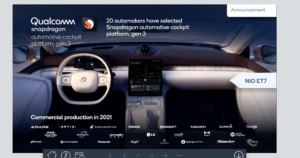Seeing Machines put out a positive year-end trading update today, without actually providing news of auto contract wins.
Fortunately, they are set to pile up over the next 6 months, with the company admitting it is bidding for a A$900m pipeline from numerous car manufacturers with 16 Tier 1s.
My view is that Seeing Machines, which has been working with the likes of Toyota and VW for years is set to take at least 75% of that pipeline. Indeed, one source (from outside the company) has already told me that A$750m is the figure I should have in mind, which would equate to over 80%. Another source (again outside the company) has recently validated my long-term bullish view on the company’s prospects in auto.
Of course, that pipeline will also grow as OEMs scale up initial contracts further. Indeed, the fact that Seeing Machines tech is now so much in demand must be the reason so many Tier 1s are now scrambling to work with it. They, unlike most investors, have seen the writing on the wall and its reads: ‘Seeing Machines DMS rules ok!’
That of course brings in the whole question of who is going to bid for the company and when?
With a A$1bn+ order book in auto set to become a reality in the present financial year, I’m sure informal approaches are becoming more regular.
But Seeing Machines is traditional and I have a feeling any match will be an arranged one. One that will need the approval of the whole family of shareholders.
However, Seeing Machines needn’t be in any rush as its value should be considered in pounds not pence. I’ve earmarked the end of calendar year 2022 as the most likely date by which we’ll have some M&A action. By then it will be clear that:
- I’m not making this stuff up.
- Aviation is another cash cow
- VR headsets/mobile phones is a likely growth area for its tech. For instance, its technology seems perfect for the next iteration of the Microsoft Hololens, which only has rudimentary eye-tracking.
The exact timing of any offer depends, of course, on contract announcements and broker upgrades as companies generally prefer de-risked investments. Still, by the end of this year I expect Seeing Machines’ auto division to be almost totally de-risked.
At this point, I want to put in a plea for Seeing Machines to engage Morgan Stanley as a broker and to ensure Adam Jonas is the analyst covering it. It is a plea I’ve made directly to the company in the past and now is certainly the time to consider it seriously.
SEE is a global leader in one of the hottest areas in tech. Waymo brags about full autonomy but in scale that is decades away. Long before then Seeing Machines tech is going to be in hundreds of millions of cars.
It therefore needs huge coverage in the US, where they naturally think big and fully value a successful global tech company. Who better than Adam Jonas to serve SEE up to the investment world?
Price
Speculating on price is a mug’s game. But then I’ve been labelled a mug multiple times for holding SEE for so many years. So here goes:
Personally, I think £1 is achievable in the next 12 months, provided:
- VW/Toyota contracts are announced before the end of 2021
- Someone admits we’re in Honda, courtesy of GM
- Qualcomm reveal more about our wins together in auto
- Volvo win is announced (Okay, I just put that in because I crave validation)
- We get at least one firm aviation licence deal
- We get Morgan Stanley (more importantly, Adam Jonas) on board
It could be a lot more by this time next year, if:
We get confirmation that our tech is being factory fitted to trucks
We get confirmation that Microsoft is putting our tech into the HoloLens headset
We get confirmation that Apple/Tesla is using us
An aviation license deal provides significant up front payments
If a bidding war were then to kick off, well it could even stretch to an Ayrton Senna. However, I’m sure a certain chip manufacturer or some Private Equity firm laden with dry powder won’t want a bidding war.
Soon, the institutional holders will have to decide: do they want a pound in the hand or a tenner in the bush?
The writer holds stock in Seeing Machines.

